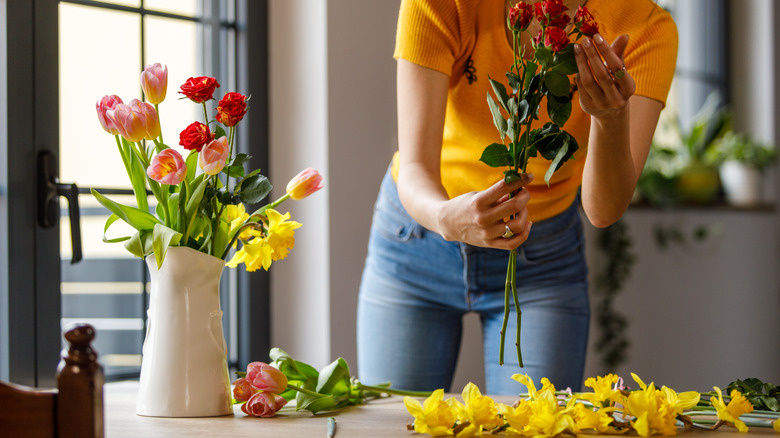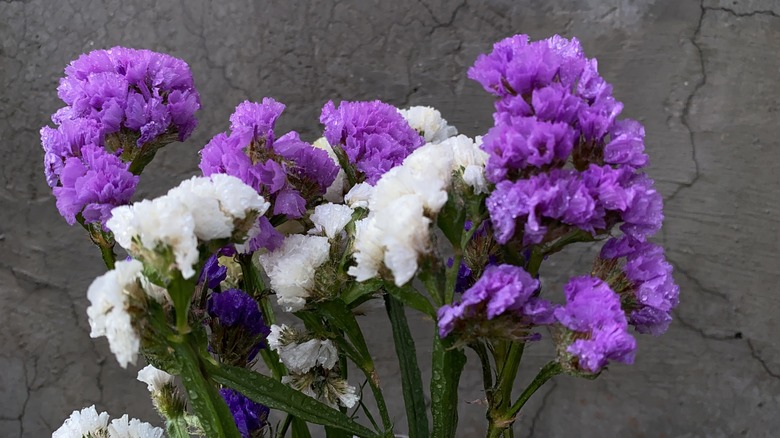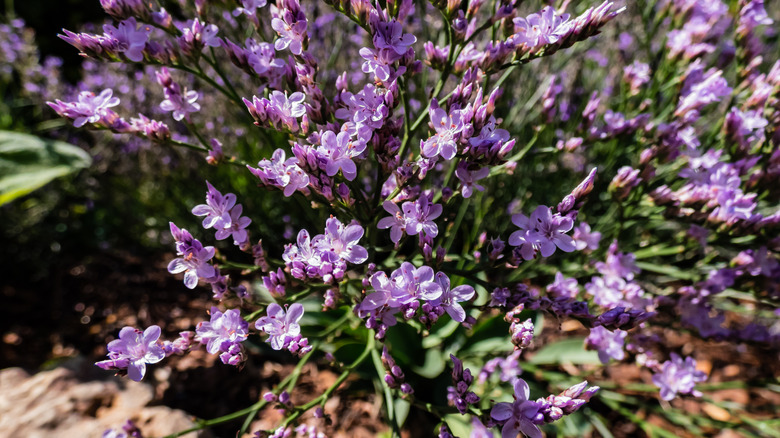The Easy-To-Grow Flower That's Perfect For Any Cut Garden
If you love blooms in your yard that you can cut and display in pretty vases indoors, you are more than likely growing a range of flowers that are perfect for a cut flower garden. A cut flower garden is not only useful but also beautiful in its own right. Imagine a garden filled with gorgeous colorful blooms such as dahlias, yellow daffodils, roses in all colors, purple ageratum, coreopsis with their bright yellow faces, and stunning gladioli. Another easy-to-grow flower to add to the mix is statice, also occasionally known as sea lavender.
With its diverse range of floral colors such as pink, purple, white, yellow, and red, it will add interest both to your garden and your floral arrangements. An added bonus is that it can also be easily dried and will brighten up your interior decor for years to come. This pretty flower is particularly popular with florists to use as a filler in their beautiful arrangements. Better still, this attractive flower is surprisingly easy to grow from seed in spring after the last frost date has passed or started indoors a few weeks earlier. It's also considered one of the best flowering plants for your garden that are deer-resistant. Here's everything you need to know about statice and how to grow it in your cut flower garden.
Everything you need to know about statice
Statice (Limonium sinuatum) is a herbaceous perennial that is native to the Mediterranean and Africa. Being a warm-climate plant means that it can only be successfully grown in USDA hardiness zones 8 through 10, where it's generally treated as an annual. However, there's another form of statice (Goniolimon tataricum), that can be grown in USDA hardiness zones 4 through 10. This particular species is native to southeast Europe, northeast Africa, and southern Russia, and is also a member of the plumbago family.
These two different species, both commonly referred to as statice or sea lavender, should give you options as to which one you can grow in your cut flower garden depending on where you live. Apart from where they can be grown, these two species do have other differences even though both are excellent for cut flowers. Limonium sinuatum has large flowers and quite thick, angular stems. On the other hand, Goniolimon tataricum has smaller flowers and much thinner but wiry stems. This latter species also has a much softer, almost cloud-like appearance when in bloom in the garden. However, both these forms of statice have blooms that will last well in a vase, and retain their color when dried and used in other floral arrangements. You'll also find that both species are summer-flowering. Once you have these growing in your garden, you might want to experiment with how to dry and style these flowers indoors.
How to easily grow statice from seed in your cut flower garden
You can easily buy statice seeds online and it's best to start these indoors around six to eight weeks before the last frost date in your region. The seeds can be started either using a seed-starting mix, premium potting soil or even just vermiculite. They will germinate in around 5 to 14 days as long as the pots are kept at a temperature of or above 70 degrees Fahrenheit. Only cover the seeds lightly with vermiculite because they need light to germinate successfully.
Make sure you harden off your seedlings before planting them straight out in the garden. Do this by placing your plants outdoors in a shady spot for a few hours on the first day and then, extending this time by a couple of hours on subsequent days while gradually exposing them to some morning sun. Extend their time in the sun for a few more days and then your plants are ready to go into the garden.
Choose a sunny spot that has well-drained soil as these plants do not tolerate wet conditions. Space your young plants around 12 inches apart. You should start to see some flowers in around three months from when the seeds were sown. Cut the flowers regularly to promote new blooms on your plants. To dry your statice flowers, tie the long stems into bunches and hang them upside down in a warm, dry spot for a couple of weeks.


